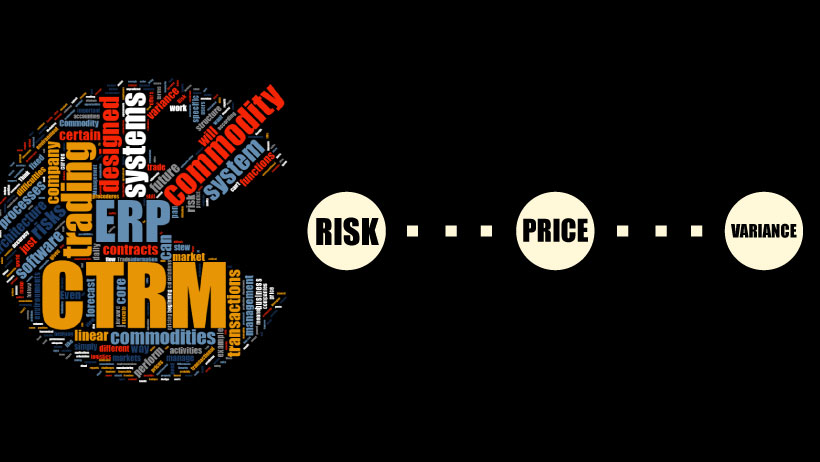A lot of people confuse CTRM software with ERP technology. Which makes complete sense, as there are of course a lot of similarities and ERP technology is the very bedrock of CTRM systems. However, CTRM software solutions are created specifically to assist the daily functions in the complex world of commodity procurement and trade. Which is why we’d like to list 5 major differences between the two. Spoiler alert: we prefer CTRM solutions ;).
You can also download this article in PDF:
CTRM or Commodity Trade and Risk Management software is a dedicated solution for commodity trading transactions and business processes. Its architecture, applications and functions should assist the daily work of all involved in a commodity trading company.
What’s more, it offers solutions to both traders and management to control and minimize the risks of the commodity trading activities and the business as a whole. Thanks to its core software, employees can perform their daily tasks and transactions accurately and efficiently. It can be made available anytime, anywhere through cloud solutions and on mobile devices. CTRM is the software-pillar for all departments in a commodity company – from logistics, trading and IT to finance and management.
CTRM: more than just an ERP
It is common knowledge that ERP systems do not really cater for commodities companies’ needs. By its very nature, the trading business differs from standard wholesale and/or manufacturing business that creates the challenge [that ERPs are unfit to handle]. Which is to say, there are differences we cannot just overcome by adding functionality to an ERP, it requires a fundamentally different approach from the get-go.
Here’s an analogy to clarify that point: you cannot use the same pan to cook eggs, pasta or stew meat. Even if you manage to fit the stew inside an egg pan, you will not be able to cook it properly. Parts of it will be spilled out onto the kitchen stove. It’s the same with the characteristics and – many – variables of the commodities business. You simply can’t have your ERP system perform all of your commodity functions, transactions and risk monitoring. Even if you attach five, ten or even dozens of “add-ons” offered by the ERP supplier, still your “stew” will be spilling out of the pan while you are cooking it. Let’s dive into 5 major differences between CTRM and ERP solutions.

CTRM vs. ERP
1. Coping with versatility
ERP software supports standardized wholesale, manufacturing and services environments. The system supports these environments from a transactional perspective and integrates with accounting applications. Its architecture eliminates variance in processes to ensure adequate production processes, related transaction management and accounting processes.
In the end, most ERPs reduce complexity and record transactions and value based on concepts like Bill of Materials or Work Break Down structures. ERP is usually centered around creating certainty and defining cost.
A CTRM on the other hand, does not reduce complexity. It enables companies to use that complexity to their benefit. Because complexity and variance are intrinsic to the commodity industry. At the very start, the quality aspects of soft and agricultural commodities may vary during the lifetime of these commodities and form the basis for the spread in monetary values and risks in trading. Down the road, one trades commodities in different markets and different currencies under different terms and thus the monetary trading values differ in all the various environments as well. A CTRM software solution enables a company to manage these complexities and benefit from them, not just to eliminate them for process or accounting purposes. CTRM, in other words, is centered around opportunity and value.
2. Facilitating hedging of trades
ERP applications mostly offer different application environments for all the different activities impacting value. Interdependence between activities or variable value drivers are difficult to manage in ERP systems – for example, when a company is using dynamic price curves, trading or hedging strategies. In an ERP environment there are limitations in viewing and using combined data information from contracts, commodity hedges or currency swaps, thus limiting integral position management, valuation and forecasting.
A CTRM tool designed for commodity procurement or trading is based on long/short position management. CTRM enables companies to manage hedge portfolios either intrinsically or through the use of derivatives and/or swaps – offering you the much-desired freedom and agility in portfolio valuation and forecasting.
3. Variance in pricing
ERP systems are usually cost-oriented and use fixed/cost prices to plan and project certain things. In commodity industries this approach is too restrained, according to Commodity CRM. It is the versatility and the variability in prices that matter and ERP applications have difficulty coping with that. For example, capturing or using “to be fixed” pricing structures, or fluid logistic terms, have proven to be difficult to manage for ERP systems.
CTRM systems easily solve the issues of future priced contracts or variable delivery terms. Commodity Trade and Risk Management systems cater for flexible volumes, prices and delivery dates without the aforementioned restrictions. Since the orientation of CTRM is on value rather than on cost, it enables companies to make pricing decisions based on value rather than on cost. Which is to say, it improves overall decision-making.

4. Architecture
Most ERP software systems have a rather linear architecture, reflecting the structure of the business they support. This means that they follow a certain line of functions and execute transaction according to their structure. Think, for example, a Work Break Down structure, a Bill of Material, a Recipe, or simply a departmental structure of a company. When you would picture such a structure you could imagine a pyramid of rectangular with linear association to each other from beginning to end. Transactions and value development through the structure would follow a rather predefined and mostly sequential flow.
CTRM systems have a unique and far from linear architecture. The architecture needs to cope with the versatility and variance and needs to support creating value from it. One could envisage such as a combination as a diamond-type of a structure combined with a spiral funnel. Even though we could observe an initial linearity, transactions and value development through the structure would follow an iterative and unpredicted or even paradoxical path. This is the very essence of a CTRM – the architecture! It is the core of your system, which has to be compatible to the characteristics of your business.
5. Risk management
Limitations in the structure and capabilities of ERP systems prevent them from being of actual use when it comes to perhaps the most vital need within the commodity trading business: managing value and risk. Commodity business have critical differences from wholesale or manufacturing or services businesses. They are just not so simple and straightforward. Even within the commodity industries, here are differences. The rules of the game, the terminology, contracts, calendars, trading methodologies may and indeed will vary across different commodities, but from company to company as well.
So, if an ERP cannot adequately capture transactions, cope with versatility and variance, and merely supports linear processes, how can it adequately support commodity risk?
The functionality of CTRM software by its very design – indeed, the architecture at its core – overcomes those difficulties in managing your commodity business. Relying on ERP (only) cannot support your business in performing efficiently due to its cost orientation and its linear architecture. Managing long/short positions, hedge portfolio’s, variable pricing, forward price curves and a value orientation are the very raison d’être of CTRM systems. For a commodity trading business or even a procurement business, a CTRM software solution with the right business fit is a prerequisite for bot short-term performance and long-term continuity, indeed existence. When selecting a CTRM for your business, it’s best to choose a CTRM system that supports the characteristics of the commodities you manage.
Would you like to know how you can integrate Agiblocks CTRM into your ERP system to have the best of both worlds? You can find out here!

